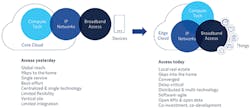Software Defined Access Networks Give You Network Agility —
Communication service providers are under pressure. With ever-increasing user demands, the explosive growth of the Internet of Things and the impending roll-out of 5G cellular, networks are becoming increasingly complex, with technology innovations creating an ever-changing architecture. These changes mean that in the coming years, every operator network will have a combination of broadband technologies, and access networks will run much more traffic alongside residential Triple Play. However, while the access network has grown exponentially in size, operators are finding that their revenues per bit are dropping due to the increased complexity associated with managing the network.
To mitigate this and remain profitable, operators need to develop new models that increase operational efficiency and network performance. Innovative techniques such as Software Defined Networking (SDN) and Network Functions Virtualization (NFV) are critical to meeting these challenges, allowing operators to build a sustainable business model that can grow in line with demand. The key to success for Software Defined Access Networks (SDAN) is now in finding the best applications for its use.
A Coming of Age
SDAN represent the next generation of intelligent access networks. Bringing virtualization into the access network gives operators the ability to more easily manage the growing complexity and related costs, as well as introducing other benefits for the installation, automation and upgradability of the network.
With the rapid development of new services, and increasing customer demands for the latest and greatest, network agility is essential for any operator that is looking to remain competitive. The decoupling of software layers from the underlying hardware allows operators to scale physical layers and service layers separately. This provides the network agility to introduce new capabilities quickly, along with the flexibility to remotely manage and automate the network from the cloud.
Another key attribute to SDAN is that it’s open from a development perspective. Gone are the black-box solutions. With the modularity of SDAN, purpose-built applications from different suppliers, and best-in-class open-source components, can be easily integrated into a single solution. This marries nicely with the unique business, regulatory, technology, and operational environment of service providers, and provides the flexibility they now require to optimize their network solutions.
However, the key to a successful network isn’t simply to virtualize everything and replace all physical infrastructure with software. While virtualization does bring significant benefits, it isn’t the silver bullet for all parts of the network. Operators should instead focus on installing virtualization platforms and services that best harness the potential for programmability, and support concrete use cases that bring value.
Software defined access networks bring data center practices and software agility to the edge of the network.
Disruptor in Residence
Removing silos is a key goal of SDAN. Virtualization requires a multi-disciplinary, horizontal approach, where different departments such as IT, network and operations come to work closer together. SDAN are also about converging more network functionality. Network slicing of the fixed access network is one of the leading SDAN-use cases that enables operators to deploy resources and networks more efficiently. Network slicing allows the physical network to be divided into multiple virtual network slices which can then be used to transport a variety of services — such as 5G on top of FTTH networks — in a fully independent way. For operating companies (OpCos) or mobile and fixed departments within one communication service provider, it can help each organizational entity maintain full independence for day-to-day operations.
Another application is sharing the network between multiple operators. While the initial benefit was increased competition through a lower cost of entry, what has emerged is a more co-operative strategy, where operators mitigate their investment risks through network slicing. This delivers a more flexible wholesaling business model and allows network owners to share the network with other operators to decrease the investment risk and accelerate ultra-broadband deployments to fixed and mobile users.
Network slicing with SDAN is a future-proof evolution to Cloud based on an open and standardized approach from the Broadband Forum. The programmability and control of the slices is fully decoupled from embedded software, and the centralized Cloud model delivers highly secure access for all tenants.
With the traffic that the next generation of fixed networks will have to handle, very low latency and high throughput will be required. With dedicated control over a dedicated set of resources, each virtual slice can have a different set of characteristics, while co-existing on the same passive optical network (PON). This includes balancing bandwidth allocation, multiplexing gains, and low latency requirements. Each slice can be controlled completely independently of the others, enabling operators to maximize usage while protecting performance. Ultimately, this multi-tenant model intelligently monetizes and operationalizes operator networks and leads to a faster return on network investment.
Another key use case that has emerged is using SDAN and the Cloud to accelerate the provisioning of next-generation technologies. One access technology where this is materializing is G.fast, giving incumbent network operators the ability to introduce and deploy multi-vendor G.fast nodes using an open modular architecture and grow the network in a consistent and automated way. With SDAN the network is always available, even when physical nodes are down or switched off, allowing operators to effortlessly replace devices or accelerate the deployment and operations through zero-touch activation and cloud-based provisioning.
Also growing is the service provider appetite for a new generation of virtualized fixed access platforms, bringing data center capabilities to the central office. Around the globe, software defined implementations that were once proof-of-concepts and lab trials are now turning into field trials, as recently evidenced by AT&T in its recent 10 Gbps XGS-PON trials.
These use cases are what is driving the evolution of SDAN, illustrating their importance in solving the problems that operators are facing in a rapidly-changing telecommunications landscape.
Back to the Future
One of the things that has hampered the spread of virtualization techniques is a lack of standards. Until recently, the industry operated almost exclusively on protocol standards, bringing all the benefits that go with it, such as choice of technology, lower price points, and innovation.
However, as the evolution of SDN/NFV and open source applications continue to accelerate, several standards are challenged with keeping pace. The popularity of open source in the telecom industry is growing but this doesn’t mean that the importance of standardization is shrinking. Open source comes with principles such as "failing fast" and creates much rework, making operators wary of committing resources to an approach that brings an increased risk of divergence and the accumulation of large technical debt.
So far, this risk has been lessened using the open and non-proprietary NETCONF/YANG protocol, which removes much of the risk of being an early adopter, and creates a reassurance that industry-wide standards are on the way. The current lack of standardization around virtualization means a new way of working for vendors and operators of working together, collaborating to define the use cases that are driving the innovation in virtualization. However, as these use cases become more prevalent, standards work will progress, and a balance must be found to deliver on the promise of programmability and openness of software defined solutions.
In an industry that develops as quickly as the telecom industry, it is easy for hype to overcome progress. Network virtualization has been talked about for many years now as a godsent boon for operators looking to improve their margins and stem the tide of increasing network complexity. However, only recently have true solutions begun to emerge that look capable of delivering on this promise.
From increased agility and faster time-to-market to cost savings and additional revenues, the potential for SDAN is huge. The technology has advanced extremely quickly over the last 12 months, and is beginning to move from trials and small-scale deployments to solidifying itself as a key part of operators’ long-term plans. SDAN provide the tool that operators have been waiting for, and its time is now.
Resources
Virtual network slicing: have your cake and eat it too by Filip De Greve. October 17, 2017. https://www.nokia.com/en_int/blog/virtualization-finally-arrives-edge-care-slice
Telefonica prepares for 5G with successful test of Nokia’s next-generation fiber technology XGS-PON. Nasdaq GlobeNewswire. December 1, 2016. https://globenewswire.com/news-release/2016/12/01/894395/0/en/Telefonica-prepares-for-5G-with-successful-test-of-Nokia-s-next-generation-fiber-technology-XGS-PON.html
Virtual attraction – what’s the killer app in G.fast virtualization? by Filip De Greve. January 4, 2017. https://www.nokia.com/en_int/blog/virtual-attraction-whats-killer-app-g-fast-virtualization
AT&T Completes Open Source XGS-PON Field Trials. AT&T Newsroom. January 16, 2018. http://about.att.com/story/xgspon_field_trials.html
About the Author


